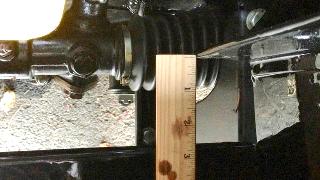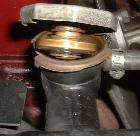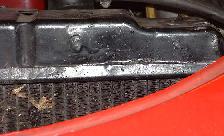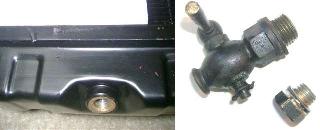The MGA With An Attitude
REPLACEMENT RADIATOR Faults - MGA -- FT-091
It is generally understood that not all replacement parts will be concours correct, exactly as original, but a minimal requirement should be that it would be functional and work at least as well as the original part. The current crop of replacement MGA radiators are, as far as I know, ALL incorrect, commonly poor quality, sometimes dysfunctional, and none will do the cooling job as well as the original radiator (although a precious few may be acceptably close to sufficient cooling capacity). To begin with, here is list of non-original features and faults to look out for.
 The first and most significant issue is non-original vertical tube core, where original radiators were cell core units. This is of course a concours no-no. It might be okay for street use, except the vertical tube radiators do not function as well as the original cell core. You may expect hot day running coolant temperature to be 10 to 20 degrees (Fahrenheit) higher with the tube-type radiator. Reason for this is because the cell core design creates turbulence in the fluid as it passes through the fluid channels, thereby transferring heat better from fluid to metal. The radiator shop's reply for this is commonly to increase the number of water tubes and number of fins in the tube type core in attempt to give it more surface area to dissipate heat. Unfortunately this results in significantly reduced air flow which reduces cooling capacity and raised fluid temperature on a hot day.
The first and most significant issue is non-original vertical tube core, where original radiators were cell core units. This is of course a concours no-no. It might be okay for street use, except the vertical tube radiators do not function as well as the original cell core. You may expect hot day running coolant temperature to be 10 to 20 degrees (Fahrenheit) higher with the tube-type radiator. Reason for this is because the cell core design creates turbulence in the fluid as it passes through the fluid channels, thereby transferring heat better from fluid to metal. The radiator shop's reply for this is commonly to increase the number of water tubes and number of fins in the tube type core in attempt to give it more surface area to dissipate heat. Unfortunately this results in significantly reduced air flow which reduces cooling capacity and raised fluid temperature on a hot day.
 A recent complaint is that many (perhaps most) current replacement radiators will be thicker than the original parts, causing (sometimes) interference between the bottom tank and the body air pan in front of the radiator. Original radiators had 2-1/4-inch thick core. Most replacement radiators have 2-1/2-inch thick core (some as large as 66-mm or 2.60-in). This may or may not work in your car, depending on factory assembly tolerances in the chassis and body panels.
A recent complaint is that many (perhaps most) current replacement radiators will be thicker than the original parts, causing (sometimes) interference between the bottom tank and the body air pan in front of the radiator. Original radiators had 2-1/4-inch thick core. Most replacement radiators have 2-1/2-inch thick core (some as large as 66-mm or 2.60-in). This may or may not work in your car, depending on factory assembly tolerances in the chassis and body panels.
Next issue is misplaced mounting flanges and/or location of the threaded and welded mounting nuts. If the mounting flanges stick out just a bit too much the radiator flanges may not fit between the 4-inch round air ducts on the body. Just as common is too wide spacing between the mounting bolts, maybe a quarter inch too far apart. Slots in the body flanges may or may not accommodate this error, but then large flat washers may not fit, so you may have to use smaller diameter washers. Also some radiators sold as replacement parts for MGA seem to have the bolt locations spaced appropriately for MGB, which is different and definitely will not work for MGA. Fixing that may require relocating some of the welded nuts, or drilling more holes and using bolts with loose nuts.

Some replacement radiators may be missing the extended overflow pipe, having instead a short stub pipe that would require a hose extension for ground drain. The overflow stub pipe can be good for hose connection to a supplemental (non-original) coolant recovery catch tank.
Some replacement radiators may have significantly thinner metal in the filler neck, giving problems with securing the pressure cap, and sometimes cracking and causing coolant leaks.
 Occasionally these may be faulty and not hold pressure when new, with either cracks or leak in the solder joints. Occasionally there may be a leak where the horizontal part of the filler neck is soldered to the front face of the top tank. For all of this it may be a good idea to pressure test the replacement radiator before installation.
Occasionally these may be faulty and not hold pressure when new, with either cracks or leak in the solder joints. Occasionally there may be a leak where the horizontal part of the filler neck is soldered to the front face of the top tank. For all of this it may be a good idea to pressure test the replacement radiator before installation.
There are recent reports of missing fan guard plate on the top tank, or missing hole in the fan guard that should accept the bonnet prop rod, or the prop rod hole being too small and having to be reamed out to accept the prop rod. Also reports of the primary fluid connector pipes being the wrong size, usually too small like 1-inch diameter where originals are 1-1/8-inch pipes for 1-1/8-inch hoses. When the pipe is too small the hose clamps have to smash the hose down to seal on the pipe, which looks bad, and original wire type hose clamps may not work at all.
Many replacement radiators have non-original top and bottom tanks with strengthening ribs and recesses in the wrong place or none at all. That is a cosmetic issue, but may be functionally okay. Quite often (maybe most of the time) the replacement radiators are missing the internal baffle in the top tank. Most people don't know about this part, that it was ever there, or what it does. Even when you do know about it, the internal baffle (if it exists or not) is mostly hidden inside and difficult to detect or inspect.
 Some replacement radiators may be missing the drain cock, or having a non-original type drain cock, or having a plug in place of the drian cock. Also the drain port (if it exists) may be too small with the wrong thread so it will not accept the original type drain valve.
Some replacement radiators may be missing the drain cock, or having a non-original type drain cock, or having a plug in place of the drian cock. Also the drain port (if it exists) may be too small with the wrong thread so it will not accept the original type drain valve.
|